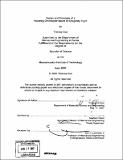Design and prototype of a hovering ornithopter based on dragonfly flight
Author(s)
Guo, Theresa (Theresa W.)
DownloadFull printable version (2.102Mb)
Other Contributors
Massachusetts Institute of Technology. Dept. of Mechanical Engineering.
Advisor
Anette E. Hosoi.
Terms of use
Metadata
Show full item recordAbstract
Hovering is normally achieved using a horizontal wing path to create lift; bees, wasps and helicopters use this technique. Dragonflies hover using a unique method, by flapping along an inclined stroke plane. This seems to create a higher efficiency than is possible for normal hovering. The aim of this project is to build a mechanical model to mimic the aerodynamic properties and hovering motion of dragonflies. Through the design and evaluation of this model, we can evaluate the mechanical feasibility of reproducing the wing path using single motor control and establish whether the difference in stroke plane is advantageous for the dragonfly. By adjusting the initial angle of attack of the ornithopter's wings, we can artificially recreate varying stroke planes. A comparison of the resultant lift generated from different stroke planes showed that greater lift forces were generated with non-zero stroke planes as demonstrated in normal hovering.
Description
Thesis (S.B.)--Massachusetts Institute of Technology, Dept. of Mechanical Engineering, 2007. Includes bibliographical references (leaf 31).
Date issued
2007Department
Massachusetts Institute of Technology. Department of Mechanical EngineeringPublisher
Massachusetts Institute of Technology
Keywords
Mechanical Engineering.